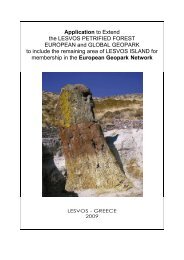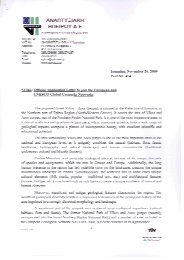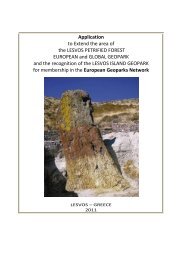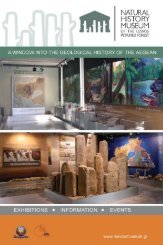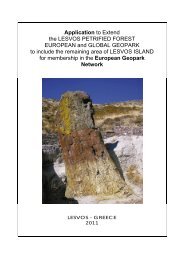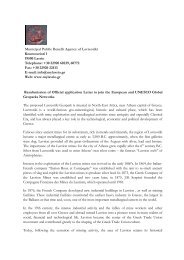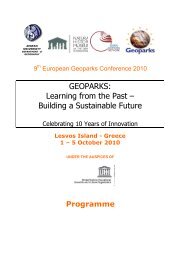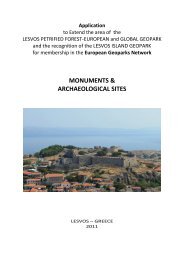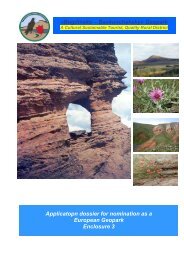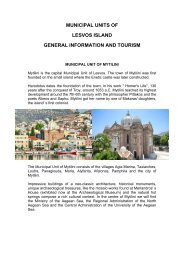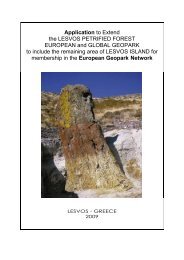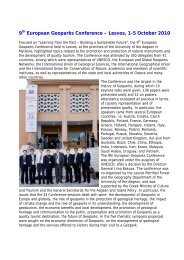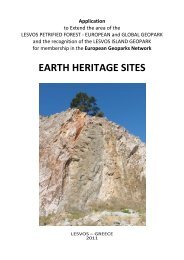Application to Extend the area of the LESVOS PETRIFIED FOREST ...
Application to Extend the area of the LESVOS PETRIFIED FOREST ...
Application to Extend the area of the LESVOS PETRIFIED FOREST ...
You also want an ePaper? Increase the reach of your titles
YUMPU automatically turns print PDFs into web optimized ePapers that Google loves.
etc. Related vegetation flourishes <strong>to</strong>day in <strong>the</strong> warm continental zones <strong>of</strong> South‐Eastern Asia<br />
and North America (Velitzelos 1988; 1993, Velitzelos & Gregor 1990, Suss & Velitzelos 1994).<br />
Standing fossilized tree trunk in <strong>the</strong> Petrified<br />
forest park at «Βali Alonia», West Lesvos. It has<br />
4,50 m high, 3,70 m perimeter and is petrified<br />
in situ on account <strong>of</strong> <strong>the</strong> intense volcanic<br />
activity in <strong>the</strong> <strong>area</strong> during Lower Miocene. The<br />
majority <strong>of</strong> <strong>the</strong> tree‐trunks in <strong>the</strong> Petrified<br />
Forest Park «Bali Alonia» belong <strong>to</strong> <strong>the</strong> species<br />
Taxodioxylon gypsaceum (GOPPERT) KRAUSEL<br />
an ances<strong>to</strong>r <strong>of</strong> <strong>the</strong> present day species Sequoia<br />
semprevirens.<br />
A comparison <strong>of</strong> <strong>the</strong> stratigraphic expanse <strong>of</strong> <strong>the</strong> plant fossils with o<strong>the</strong>r European flora and<br />
with <strong>the</strong> Palae<strong>of</strong>lora <strong>of</strong> Greece leads <strong>to</strong> <strong>the</strong> conclusion that <strong>the</strong> Palae<strong>of</strong>lora <strong>of</strong> Lesvos developed<br />
during Lower Miocene, under subtropical or warm temperate seasonal climatic conditions.<br />
The high proportion <strong>of</strong> upright petrified tree trunks, with well preserved roots in <strong>the</strong> fossilised<br />
soil, allows us <strong>to</strong> infer that <strong>the</strong> petrified forest <strong>of</strong> Lesvos island represents a complete<br />
au<strong>to</strong>chthonous (fossilised in situ) ecosystem.<br />
The Fossilised Forest was developed during <strong>the</strong> time period from <strong>the</strong> end <strong>of</strong> <strong>the</strong> Late Oligocene<br />
<strong>to</strong> Lower ‐ Middle Miocene (ca. 20‐15 million years before present), in contrast <strong>to</strong> most well<br />
known fossilised forests on Earth, which developed in earlier geological periods. According <strong>to</strong><br />
recent data, <strong>the</strong> composition <strong>of</strong> <strong>the</strong> fossil flora is characterised by a high proportion <strong>of</strong><br />
angiosperms (flowering plants) and gym‐nosperms (conifers), and a low proportion <strong>of</strong><br />
Pteridophytes (ferns). The silicified tree trunks and <strong>the</strong>ir organs ‐ especially <strong>the</strong> wood ‐ are very<br />
well preserved. Fur<strong>the</strong>rmore, fossilised leaves, cones and seeds provide <strong>the</strong> raw data for<br />
important scientific studies. Taxonomic study <strong>of</strong> <strong>the</strong> flora shows that <strong>the</strong>y do not grow <strong>to</strong>day in<br />
8



